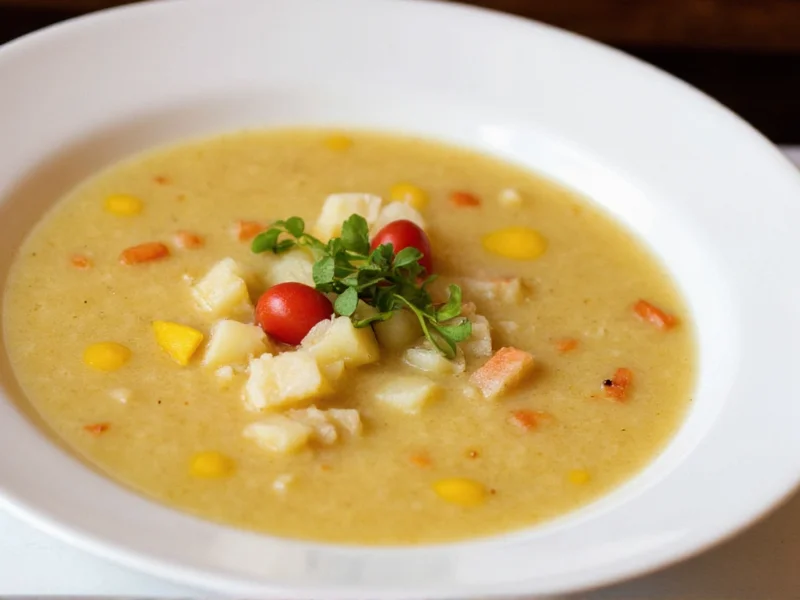Choosing the right potato variety can make or break your soup's texture and flavor. The difference between a perfectly textured chowder and a mushy mess often comes down to selecting the appropriate potato type for your specific soup recipe. Understanding potato starch content—the key factor determining how potatoes behave during cooking—is essential for soup success.
Understanding Potato Starch Content and Soup Applications
Potatoes fall into three main categories based on starch content, each behaving differently when cooked in liquid:
- High-starch potatoes (like Russets) break down easily, releasing starch that thickens soups naturally
- Medium-starch potatoes (like Yukon Golds) offer the best balance, providing creaminess while maintaining some structure
- Low-starch/waxy potatoes (like red potatoes) hold their shape remarkably well in simmering broth
The starch content directly impacts your soup's final texture. High-starch varieties create that desirable creamy mouthfeel in pureed soups without requiring excessive cream or thickeners, while waxy potatoes ensure distinct chunks remain intact in hearty vegetable soups.
Top Potato Varieties for Soup Applications
| Potato Variety | Starch Level | Best Soup Applications | Key Characteristics |
|---|---|---|---|
| Yukon Gold | Medium | Cream soups, chowders, potato leek | Naturally buttery flavor, creates creamy texture without disintegrating |
| Russet/Baking | High | Pureed soups, thick chowders | Breaks down completely, excellent natural thickener |
| Red Potatoes | Low (Waxy) | Chunky vegetable soups, minestrone | Holds shape beautifully, maintains firm texture |
| Fingerling | Low-Medium | Specialty soups, gourmet preparations | Unique texture, holds shape with buttery flavor |
| Yellow Finn | Medium | Versatile for most soup types | Similar to Yukon Gold with slightly denser texture |
Matching Potatoes to Specific Soup Types
Creamy Soups and Chowders
For velvety potato soup, chowder, or bisque, Yukon Gold potatoes deliver exceptional results. Their medium starch content provides natural creaminess without requiring excessive dairy. When making clam chowder, Yukon Golds create that signature smooth yet slightly textured consistency that defines New England-style chowder. The best potatoes for creamy soup maintain structural integrity while contributing body to the broth.
Chunky Vegetable Soups
When preparing hearty vegetable soup, minestrone, or bean soup where distinct potato pieces should remain intact, waxy red potatoes are ideal. These potatoes that don't fall apart in soup maintain their shape through extended simmering. Their thin skins don't require peeling, adding both visual appeal and nutrients to your soup. For soups that cook for hours, waxy varieties prevent the "mushy potato" problem that ruins otherwise excellent recipes.
Pureed Soups
Russet potatoes excel in pureed applications like classic French potato leek soup. Their high starch content breaks down completely during cooking, creating an exceptionally smooth texture that requires minimal blending. When making soup without a blender, russets provide the thickest, most luxurious consistency. The best potatoes for pureed soup essentially melt into the broth, eliminating the need for additional thickeners.
Professional Tips for Perfect Potato Soup
Timing Matters
Add potatoes to soup at the right stage: for chunky soups, add waxy potatoes during the last 20-25 minutes of cooking; for creamy soups, add medium-starch potatoes about 30 minutes before finishing to allow proper breakdown. When making soup with multiple potato types, add high-starch varieties first and waxy potatoes later.
Cutting Techniques
Cut potatoes uniformly to ensure even cooking—aim for 3/4-inch cubes for chunky soups. For pureed soups, larger chunks (1-1.5 inches) work better as they break down more evenly. Never cut potatoes too small for chunky soups, as this increases the surface area exposed to liquid, accelerating disintegration.
Preventing Common Problems
To avoid potatoes becoming waterlogged, add them to already hot (not boiling) soup. For acidic soups (like tomato-based), add potatoes later in the cooking process as acid prevents proper softening. If your soup becomes too thick, use potato cooking liquid or broth—not water—to adjust consistency while maintaining flavor.
Common Mistakes to Avoid
Many home cooks make the error of using only one potato variety for all soups. Understanding which potatoes hold shape in soup versus those that create creaminess is crucial. Another frequent mistake is adding potatoes too early, resulting in disintegrated chunks in chunky soups. For the best results with waxy potatoes for vegetable soup, resist the urge to stir too vigorously, which can break down even the most shape-retentive varieties.











 浙公网安备
33010002000092号
浙公网安备
33010002000092号 浙B2-20120091-4
浙B2-20120091-4